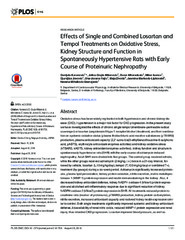Prikaz osnovnih podataka o dokumentu
Effects of Single and Combined Losartan and Tempol Treatments on Oxidative Stress, Kidney Structure and Function in Spontaneously Hypertensive Rats with Early Course of Proteinuric Nephropathy
| dc.creator | Karanović, Danijela | |
| dc.creator | Grujić-Milanović, Jelica | |
| dc.creator | Miloradović, Zoran | |
| dc.creator | Ivanov, Milan | |
| dc.creator | Jovović, Đurđica | |
| dc.creator | Vajić, Una Jovana | |
| dc.creator | Životić, Maja | |
| dc.creator | Marković-Lipkovski, Jasmina | |
| dc.creator | Mihailović-Stanojević, Nevena | |
| dc.date.accessioned | 2021-04-20T12:50:07Z | |
| dc.date.available | 2021-04-20T12:50:07Z | |
| dc.date.issued | 2016 | |
| dc.identifier.issn | 1932-6203 | |
| dc.identifier.uri | http://rimi.imi.bg.ac.rs/handle/123456789/742 | |
| dc.description.abstract | Oxidative stress has been widely implicated in both hypertension and chronic kidney disease (CKD). Hypertension is a major risk factor for CKD progression. In the present study we have investigated the effects of chronic single tempol (membrane-permeable radical scavenger) or losartan (angiotensin II type 1 receptor blocker) treatment, and their combination on systemic oxidative status (plasma thiobarbituric acid-reactive substances (pTBARS) production, plasma antioxidant capacity (2,2'-azino-bis(3-ethylbenzothiazoline-6-sulphonic acid, pABTS), erythrocyte antioxidant enzymes activities) and kidney oxidative stress (kTBARS, kABTS, kidney antioxidant enzymes activities), kidney function and structure in spontaneously hypertensive rats (SHR) with the early course of adriamycin-induced nephropathy. Adult SHR were divided into five groups. The control group received vehicle, while the other groups received adriamycin (2 mg/kg, i.v.) twice in a 21-day interval, followed by vehicle, losartan (L, 10 mg/kg/day), tempol (T, 100 mg/kg/day) or combined T+L treatment (by gavage) during a six-week period. Adriamycin significantly increased proteinuria, plasma lipid peroxidation, kidney protein oxidation, nitrite excretion, matrix metalloproteinase-1 (MMP-1) protein expression and nestin immunostaining in the kidney. Also, it decreased kidney antioxidant defense, kidney NADPH oxidase 4 (kNox4) protein expression and abolished anti-inflammatory response due to significant reduction of kidney NADPH oxidase 2 (kNox2) protein expression in SHR. All treatments reduced protein-to-creatinine ratio (marker of proteinuria), pTBARS production, kidney protein carbonylation, nitrite excretion, increased antioxidant capacity and restored kidney nestin expression similar to control. Both single treatments significantly improved systemic and kidney antioxidant defense, bioavailability of renal nitric oxide, reduced kMMP-1 protein expression and renal injury, thus retarded CKD progression. Losartan improved blood pressure, as well astubular injury and restored anti-inflammatory defense by reverting kNox2 expression to the control level. Interestingly, tempol was more successful in reducing systemic oxidative stress, proteinuria, kMMP-1 and glomerulosclerosis. However, combined treatment failed to overcome the beneficial effects of single treatments in slowing down the progression of ADR-induced nephropathy in SHR. | en |
| dc.publisher | Public Library Science, San Francisco | |
| dc.relation | info:eu-repo/grantAgreement/MESTD/Basic Research (BR or ON)/175096/RS// | |
| dc.rights | openAccess | |
| dc.rights.uri | https://creativecommons.org/licenses/by/4.0/ | |
| dc.source | PLoS One | |
| dc.title | Effects of Single and Combined Losartan and Tempol Treatments on Oxidative Stress, Kidney Structure and Function in Spontaneously Hypertensive Rats with Early Course of Proteinuric Nephropathy | en |
| dc.type | article | |
| dc.rights.license | BY | |
| dc.citation.issue | 8 | |
| dc.citation.other | 11(8): - | |
| dc.citation.rank | M21 | |
| dc.citation.volume | 11 | |
| dc.identifier.doi | 10.1371/journal.pone.0161706 | |
| dc.identifier.fulltext | http://rimi.imi.bg.ac.rs/bitstream/id/564/739.pdf | |
| dc.identifier.pmid | 27560781 | |
| dc.identifier.scopus | 2-s2.0-84990052972 | |
| dc.identifier.wos | 000382258600082 | |
| dc.type.version | publishedVersion |

